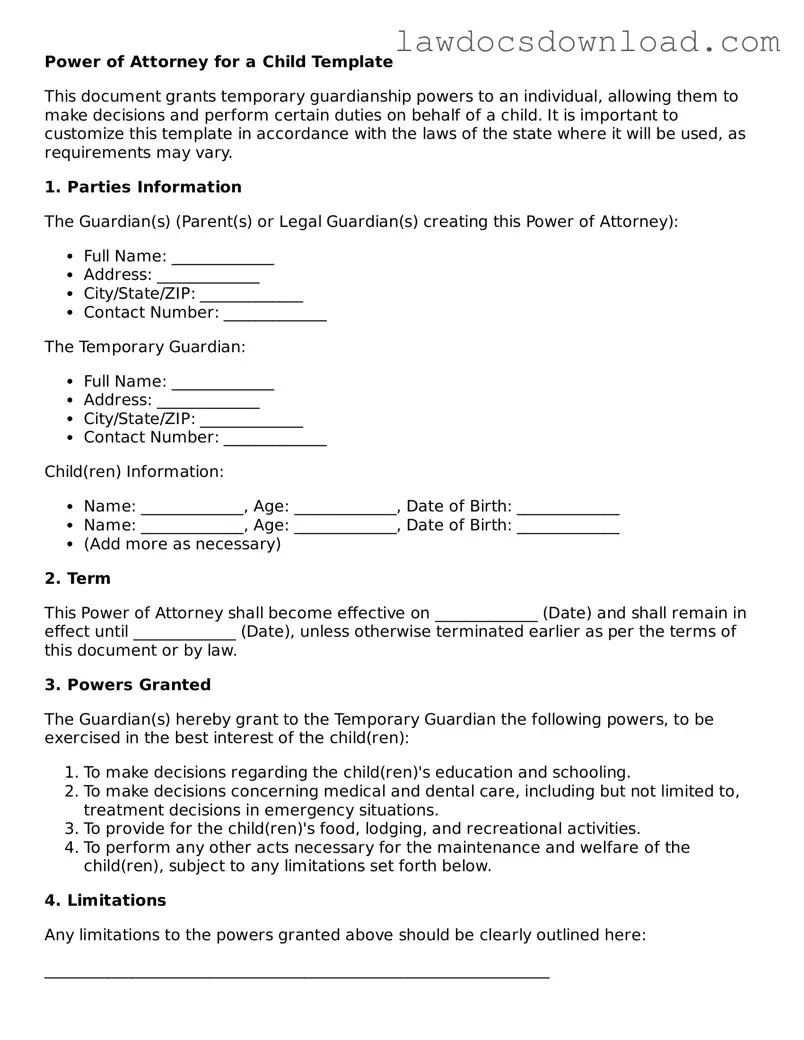Power of Attorney for a Child Template
This document grants temporary guardianship powers to an individual, allowing them to make decisions and perform certain duties on behalf of a child. It is important to customize this template in accordance with the laws of the state where it will be used, as requirements may vary.
1. Parties Information
The Guardian(s) (Parent(s) or Legal Guardian(s) creating this Power of Attorney):
- Full Name: _____________
- Address: _____________
- City/State/ZIP: _____________
- Contact Number: _____________
The Temporary Guardian:
- Full Name: _____________
- Address: _____________
- City/State/ZIP: _____________
- Contact Number: _____________
Child(ren) Information:
- Name: _____________, Age: _____________, Date of Birth: _____________
- Name: _____________, Age: _____________, Date of Birth: _____________
- (Add more as necessary)
2. Term
This Power of Attorney shall become effective on _____________ (Date) and shall remain in effect until _____________ (Date), unless otherwise terminated earlier as per the terms of this document or by law.
3. Powers Granted
The Guardian(s) hereby grant to the Temporary Guardian the following powers, to be exercised in the best interest of the child(ren):
- To make decisions regarding the child(ren)'s education and schooling.
- To make decisions concerning medical and dental care, including but not limited to, treatment decisions in emergency situations.
- To provide for the child(ren)'s food, lodging, and recreational activities.
- To perform any other acts necessary for the maintenance and welfare of the child(ren), subject to any limitations set forth below.
4. Limitations
Any limitations to the powers granted above should be clearly outlined here:
________________________________________________________________
________________________________________________________________
5. Governing Law
This Power of Attorney shall be governed by the laws of the State of _____________.
6. Acknowledgment by Guardian(s)
I/We, the undersigned Guardian(s), acknowledge that I/we have read and understand this Power of Attorney and the powers being granted to the Temporary Guardian. I/We have executed this document on _____________ (Date).
Guardian's Signature: _____________
Date: _____________
Guardian's Signature: _____________
Date: _____________
7. Acknowledgment by Temporary Guardian
I, the undersigned Temporary Guardian, acknowledge that I have read and understand this Power of Attorney and the powers being granted to me. I accept the responsibility and agree to act in the best interest of the child(ren) as outlined in this document. Executed on _____________ (Date).
Temporary Guardian's Signature: _____________
Date: _____________
8. Witness Acknowledgment
This document was signed in the presence of a witness, who attests to the authenticity of the signatures herein.
Witness's Signature: _____________
Date: _____________
